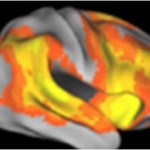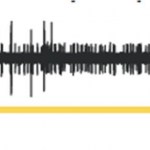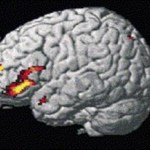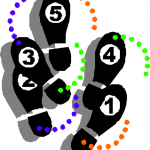
A nice 2010 Human Brain Mapping paper by Church, Petersen & Schlaggar covers a number of interpretational issues confronting modern neuroimaging. Their particular application is pediatric neuroimaging (I will also use developmental examples), but the general issues apply to nearly all fMRI studies. So here are some important things to keep in mind whenever you read an fMRI study:
1. "The Performance Burden" If neural activity is found to differ between groups or conditions, you can't necessarily make inferences about differences in neural information processing - this could reflect…
A 2010 FINS paper from Cohen et al. demonstrates that multivariate patterns in neural recruitment during response inhibition across the brain are significantly predictive of response inhibition ability and age of the scanned subject, and shows that other factors (such as response variability and reaction times) cannot be similarly predicted from the same data.
Cohen et al asked twenty-seven 9-19 year-olds and nine 25-30 year-olds to complete a standard "stop signal" task. On 75% of trials ("Go trials") this task is identical to a 2-choice reaction time task (i.e., as quickly as possible…
What if we got the organization of prefrontal cortex all wrong - maybe even backwards? That seems to be a conclusion one might draw from a 2010 Neuroimage paper by Yoshida, Funakoshi, & Ishii. But that would be the wrong conclusion: thanks to an ingenious mistake, Yoshida et al have apparently managed to "reverse" the functional organization of prefrontal cortex.
First things first: the task performed by subjects was very tricky. Yoshida et al asked subjects to sort three stimuli, which were presented simultaneously. Each of the three differs from each other in three ways: number of…
Hierarchical views of prefrontal organization posit that some information processing principle, and not just task difficulty, determines which areas of prefrontal cortex will be recruited in a given task. Virtually all information processing accounts of the prefrontal hierarchy are agreed on this point, though they differ in whether the operative principle is thought to be the temporal duration over which information must be maintained, the relational complexity of that information, the number of conditionalities necessary to consider in behaving on that information, or the inherent…
How does the brain deal with the need to pursue multiple goals simultaneously, particularly if they are associated with different reward values?
One idea, perhaps far-fetched, is that the brain might divvy up responsibility for tracking these goals & rewards: for example, the left hemisphere might respond to a primary goal, and the right hemisphere to secondary goals. To me, this kind of simple division of labor smells like lots of ridiculous and outdated hemispheric asymmetry theories. That's why I'm dumbfounded that new evidence provides startling support for it, as reported in a…
In the early days of functional magnetic resonance imaging (fMRI), researchers were eager to point out that the hemodynamic response measured by fMRI may correspond rather directly to neural firing. Recently, a number of researchers have attempted to remind the larger neuroimaging community that the hemodynamic response reflects metabolic/energetic demands, and this might very well more strongly reflect the firing of inhibitory interneurons that oppose the action of the excitatory pyramidal neurons we more commonly think about. This kind of confusion has consequences: many have argued that…
When I started this blog back in '06, new hypotheses were appearing on a possible functional architecture of the lateral prefrontal cortex - a recently-evolved brain area implicated in high-level cognitive functions like planning, analogical reasoning, and cognitive control. Since then, these hypotheses have been refined, and the results replicated numerous times.
Today, it's essentially incontrovertible that the prefrontal cortex is parcellated into a functional hierarchy in which more anterior areas influence processing in more posterior areas according to the more abstract information…
A fascinating paper from Gradinaru et al describes a genetically engineered mouse model of Parkinson's disease that expresses a photoreceptor in the neurons of a particular part of the brain - the subthalamic nucleus (STN). This area is widely thought to be the central target of the immensely therapeutic technique for Parkinson's known as deep brain stimulation. With this photoreceptor in place, the authors could direct laser light to that area of the brain and direactly affect neural activity - in particular, whether the behavioral symptoms of Parkinson's would disappear following…
A number of very smart people (and smart communities) seem like they might be under the impression that the "voodoo correlations" scandal in the neuroimaging community is somehow related to recent work by Bennett et al, who used fMRI to show task-related neural activity in a dead fish.
These two things have almost nothing to do with one another.
1) The Bennett work is, in the words of a friend, "a cute way to make a point" that every fMRI paper I've ever read has failed to explicitly acknowledge. The reason they've failed to acknowledge it is that it's standard to run equivalent statistical…
Something's afoot when a massively parallel and distributed system shows a bottleneck in performance. We've known that numerous bottlenecks plague cognition since the 1940's, but only with recent advances in neuroimaging have we been able to say whether these bottlenecks reflect the intrusion of executive operations (for managing goals and organizing cognitive processing) or a more passive "queueing" processes inherent to the selection of responses. Thanks to a number of very helpful (and interesting) reviews on a recent paper of mine, I've been pointed towards a fascinating study (by Jiang…
I've been busy writing up a new paper, and expect the reviews back on another soon, so ... sorry for the lack of posts. But this should be of interest:
The Dana Foundation has just posted an interview with Terrence Sejnowki about his recent Science paper, "Foundations for a New Science of Learning" (with coauthors Meltzoff, Kuhl & Movellan). Sejnowski is a kind of legendary figure in computational neuroscience, having founded the journal Neural Computation, developed the primary algorithm in independent components analysis (infomax), contrastive hebbian learning, and played an early…
Children assigned to chew sugar-free gum purportedly score 3% higher on standardized tests of math skills (as widely reported in the press). But is this just one of the 5% of all possible untrue hypotheses statistically guaranteed to have some significant result in its favor (in fact, it's worse than that)? Is the effect due to some other aspect of gum chewing (as Michael Posner asks)? Or might there be a real effect here of chewing (i.e., "mastication"), and if so, how can you use it to your maximum advantage?
What we know - and what we don't - about gum and cognition
To cut to the chase…
The UCLA Neuroimaging Summer Education Program starts today at 8:30 am Pacific. Standard Time - and is going to be streaming live at this address (video embedded below). The schedule is quite impressive, including talks from Rick Buxton, Mark Cohen, Russ Poldrack, Vince Calhoun, and Jose Hanson among others. Topics include everything from causal modeling to network analysis and multivariate pattern recognition.
Monday, July 20
08:30 Intro & overview (Russ Poldrack & Mark Cohen)
09:30 MRI acquisition: basics (Mark Cohen)
11:00 Ethical issues in cognitive neuroscience (Russ Poldrack…
How many times did Pavlov ring the bell before his dogs' meals until the dogs began to salivate? Surely, the number of experiences must make a difference, as anyone who's trained a dog would attest. As described in a brilliant article by C.R. Gallistel (in Psych. Review; preprint here), this has been thought so self-evident "as to not require experimental demonstration" - yet information theoretic analysis suggest the idea is incorrect, at least when the time from the bell to the food is constant. More problematic is the fact that the whole issue is ill-formed for experimental verification…
Don't think of a white bear. Doesn't work so well, does it? Yet under some circumstances, people appear to be able to do precisely this: as described last week, young adults are thought (by some) to actually suppress the neural activity related to to-be-ignored stimuli, and even delay the peak of this neural activity, relative to a situation in which stimuli are to be just passively-viewed. In a follow-up paper at Nature Neuroscience, Gazzaley et al report that cognitively-intact older adults (60-77 years of age) show an impairment in this ability, without concomitant impairments in the…
An interesting video interview with the author of (the excellent) Mind Wars.
Here are direct links to the videos.
The cognitive neurosciences have had high frequency oscillations on the brain: so called "gamma-waves", as recorded on the scalp, have been linked to working memory processes (via their interaction with slower "theta waves"), to cognitive insight, and even to consciousness. (I think there's an unwritten rule that whenever someone mentions consciousness, they'll be made to look foolish by a subsequent paper). In the midst of these "inflationary accounts" of the role of gamma oscillations, a debate has emerged: could these oscillations (at least, as recorded on the scalp) reflect simply the…
By many current theories, we accomplish control over behavior by using the prefrontal cortex to "bias" the competitive dynamics playing out in the rest of the brain. By some models, this bias is positive - it helps the goal-relevant representations win the competition. By other models, the bias is also negative - it can help the goal-irrelevant representations lose the competition. Regardless, this "prefrontal biasing" is usually considered in terms of the amount of activity in a particular area (higher when that area is under a positive bias, and lower when under a negative bias). But…
A new study suggests that physically stepping backwards may be associated with gains in the ability to deal with problematic situations. As newly reported in Psychological Science (hat tip to Hannah) by Koch, Holland, Hengstler & Knippenberg, people were better able to resolve interference in laboratory "Stroop" task after stepping backwards, relative to stepping to the side or forwards. The authors argue that stepping backwards is typically associated with problematic situations, which characteristically require cognitive control (the set of capacities which enable us to control our…
Every now and then, I read some science from some other dimension. That is, the methods are so unusual, the relevant theories so fringe, or the conclusions so startling that I feel like the authors must be building on work from a completely separate science, with its own theories and orthodoxy. This can be good or bad, and is usually the latter. But in the case of Zhang & Luck's recent papers, it's very, very good.
To appreciate what they've done, here's a little background from this dimension's science - specifically, the science of forgetting. The phenomenon of "forgetting" has been…



